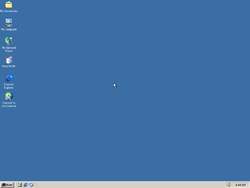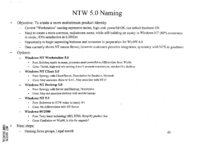Windows 2000
| Version of Microsoft Windows | |||||||||||||||||||
 | |||||||||||||||||||
| OS family | Windows NT | ||||||||||||||||||
|---|---|---|---|---|---|---|---|---|---|---|---|---|---|---|---|---|---|---|---|
| Version | 5.0 | ||||||||||||||||||
| Codename | Memphis NT | ||||||||||||||||||
| Preliminary name | Windows NT 5.0 | ||||||||||||||||||
| Architecture | x86, PC98 | ||||||||||||||||||
| Release date | 2000-02-17 | ||||||||||||||||||
| Support end | 2010-07-13 | ||||||||||||||||||
| SKUs | |||||||||||||||||||
| Professional Server Advanced Server Datacenter Server Powered | |||||||||||||||||||
| Replaces | |||||||||||||||||||
| Windows NT 4.0 | |||||||||||||||||||
| Replaced by | |||||||||||||||||||
| Windows XP, Windows Server 2003 | |||||||||||||||||||
| Microsoft Windows 2000 | |
| Codename(s) | NT 5.0 |
|---|---|
| Kernel version | NT 5.0 |
| CPU Architecture | x86, IA-64 |
| Release date | 17/02/2000 |
| Licence | Microsoft EULA |
| Support end | Expired 13/07/2010 |
| Other versions | |
| Previous: Windows NT 4.0 | Next: Neptune / Windows XP |
Windows 2000, also known as Windows NT 5.0, was the last version of the Windows NT line of operating systems which was released for business users only and succeeded Windows NT 4.0. It is still branded with «Based on NT Technology», possibly to prevent confusion with the 9x line (which was also named after the year of release at that time). This was done between Beta 2 and 3 stages, somewhere between builds 1911.1 and 1946.1. Extended support ended in 2010. It is the last version of Windows NT to include NT in its product name.
Contents
Editions
Windows 2000 was released in Workstation (Professional) and Server (Advanced Server, Datacenter Server, Server) editions.
Information about each edition borrowed from Wikipedia, the free encyclopedia.
Professional
It is the client version of Windows 2000. It offers greater security and stability than many of the previous Windows desktop operating systems. It supports up to two processors and can address up to 4 GB of RAM. The system requirements are a Pentium processor (or equivalent) of 133 MHz or greater, at least 32 MB of RAM, 650 MB of hard drive space, and a CD-ROM drive (recommended: Pentium II, 128 MB of RAM, 2 GB of hard drive space, and CD-ROM drive).
Server
It shares the same user interface with Windows 2000 Professional but contains additional components for the computer to perform server roles and run infrastructure and application software. A significant new component introduced in the server versions is Active Directory, which is an enterprise-wide directory service based on LDAP. Additionally, Microsoft integrated Kerberos network authentication, replacing the often-criticised NTLM authentication system used in previous versions. This also provided a purely transitive-trust relationship between Windows 2000 domains in a forest (a collection of one or more Windows 2000 domains that share a common schema, configuration, and global catalog, being linked with two-way transitive trusts). Furthermore, Windows 2000 introduced a Domain Name Server which allows dynamic registration of IP addresses. Windows Server 2000 supports up to 4 processors, requires 128 MB of RAM and 1 GB hard disk space, however requirements may be higher depending on installed components.
Advanced Server
It is a variant of Windows Server 2000 operating system designed for medium-to-large businesses. It offers clustering infrastructure for high availability and scalability of applications and services, including main memory support of up to 8 gigabytes (GB) on Physical Address Extension (PAE) systems and the ability to do 8-way SMP. It supports TCP/IP load balancing and enhanced two-node server clusters based on the Microsoft Cluster Server (MSCS) in Windows NT Server 4.0 Enterprise Edition. Limited number of copies of an IA-64 version, called Windows Advanced Server 2000, Limited Edition were made available via OEMs. System requirements are similar to those of Windows Server 2000 however, they may need to be higher to scale to larger infrastructure.
Datacenter Server
It is a variant of Windows Server 2000 designed for large businesses that move large quantities of confidential or sensitive data frequently via a central server. Like Advanced Server, it supports clustering, failover and load balancing. Its minimum system requirements are normal, but it was designed to be capable of handling advanced, fault-tolerant and scalable hardware—for instance computers with up to 32 CPUs and 64 GBs RAM, with rigorous system testing and qualification, hardware partitioning, coordinated maintenance and change control. A limited number of copies of an IA-64 version of Windows Server 2000, called Windows Datacenter Server 2000 Limited Edition were made available via OEMs. System requirements are similar to those of Windows Advanced Server 2000 however, they may need to be higher to scale to larger infrastructure.
Service Packs
In all, there were four service packs released for Windows 2000. All are considered as abandonware as of 2013.
Service Pack 1
Service Pack 1 was released on 15 August 2000.
Service Pack 2
Service Pack 2 was released on 16 May 2001.
Windows 2000 beta 3
Windows 2000 (также называемая Win2k, W2k или Windows NT 5.0) — операционная система семейства Windows NT корпорации Microsoft, предназначенная для работы на компьютерах с 32-битными процессорами. Первая публичная бета-версия системы была выпущена 23 сентября 1997 года на Professional Developers Conference. Изначально система носила название Windows NT 5.0, поскольку была следующей крупной версией Windows NT после Windows NT 4.0. Однако 27 октября 1998 года она получила собственное название Windows 2000. Финальная версия системы была выпущена для широкой общественности 17 февраля 2000 года.Корпорация Microsoft 30 июня 2005 года прекратила основную поддержку операционной системы Windows 2000, а 13 июля 2010 года — расширенную.
Windows 2000 Professional являлась настольной операционной системой для бизнеса и конечных пользователей. Предлагалась высокая безопасность и стабильность в отличие от прошлых версий Windows. ОС поддерживала работу двух процессоров и оперативной памяти до 4 ГБ.
Windows 2000 Server имела похожий с Windows 2000 Professional интерфейс, однако содержала дополнительные компоненты для серверной части инфраструктуры. Важным новым компонентом стала функция Active Directory, которая была основана на технологии LDAP. В дополнение Microsoft интегрировала аутентификацию через Kerberos, заменив критикуемый метод NTLM. Кроме того в Windows 2000 можно было использовать доменное имя, что позволяло использовать динамический IP.
Windows 2000 Advanced Server — это вариант версии ОС Windows 2000 Server, но спроектированный для среднего и большого бизнеса. Здесь уже предлагалось использование кластерной инфраструктуры для повышенной гибкости и надёжности системы, включалась поддержка уже восьми процессоров, оперативной памяти до 8 ГБ на системах с PAE и поддержка восьмиполосной симметричной мультипроцессорности. Кроме всего прочего была поддержка балансировки загрузки TCP/IP и расширенные двусерверные кластеры на Microsoft Cluster Server с Windows NT Server 4.0 Enterprise Edition.
Windows 2000 Datacenter Server вариант Windows 2000 Server для большого бизнеса, позволяющая иметь большие объёмы информации на одном центральном сервере. Также как и Advanced Server, данная версия поддерживала кластеризацию, отказоустойчивость и балансировку загрузки. Здесь уже осуществлялась поддержка 32 процессоров и 32 ГБ оперативной памяти со строгой системой тестирования, аппаратного разбиения на разделы, координированное техническое обслуживание и контроль изменений.
Сообщение отредактировал Reiju — 07.07.20, 16:38


